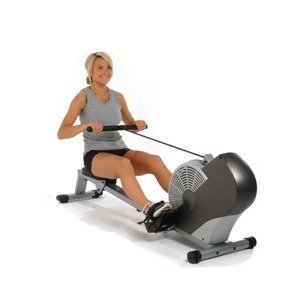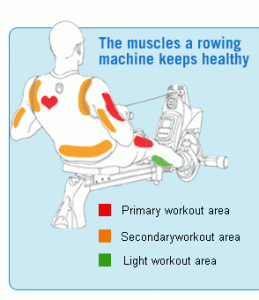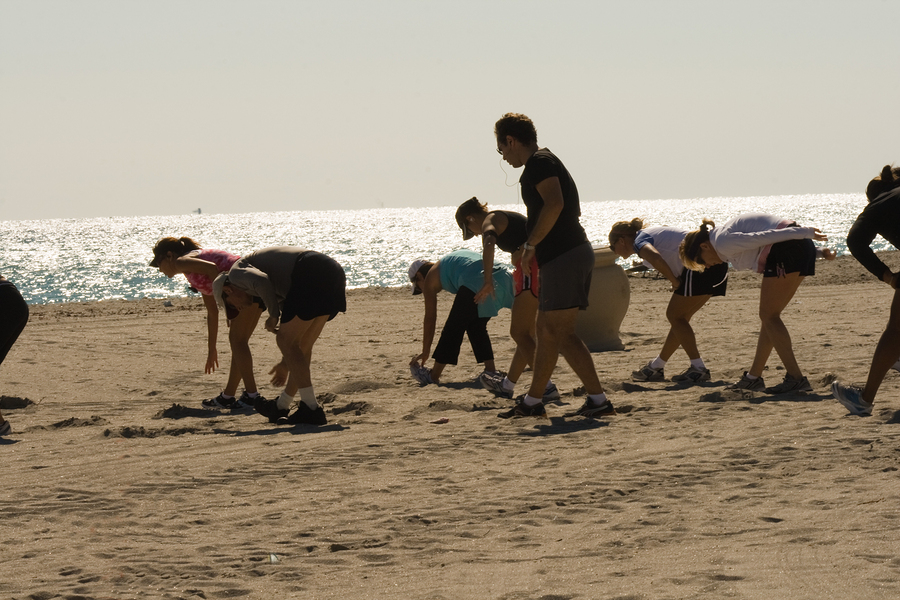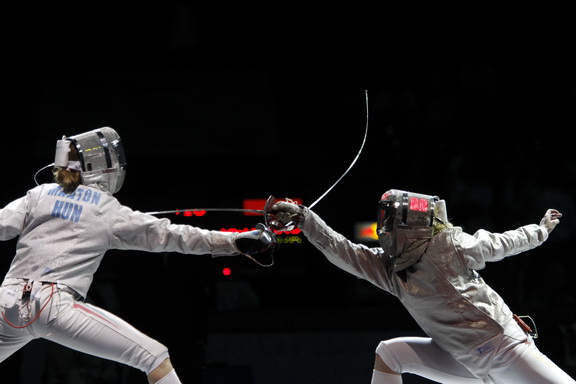
Rowing is an efficient and effective low-impact exercise that utilizes the arms, abdomen, back and legs, providing a total-body workout. This activity offers the opportunity for a wide range of training from fat burning and aerobic conditioning to high-intensity anaerobic and interval VO2max training. The rowing stroke is a smooth continuous, non-impact movement. If you have a history of low back pain, special attention must be given to developing proper rowing technique to prevent injury.
Selecting a Rowing Machine
The rowing machine should mimic the smooth motion of rowing on the water. The machine and platform must be of sturdy construction and able to easily support the weight of the person rowing. The seat should be comfortable, but not too soft. The seat must slide back and forth smoothly and allow for full extension and flexion of the knees. There should be plenty of room in front of the person rowing to allow for full extension of the shoulders and arms at the beginning of the rowing motion. The “oar” handle should be centered in front and enable a full range of motion in a straight horizontal plane. There should be a smooth, seamless uptake of the resistance throughout the rowing stroke. Avoid machines that feature a jerky sensation of resistance change, or sudden change in resistance. The rowing machine should allow for the easy adjustment of the resistance, even from one stroke to another.
Many rowing machines are equipped with a monitor that will indicate pace, distance, power output (watts), calories burned, and heart rate. Some may also be programmed for a workout including distance or time rowed and the rest period between intervals. More sophisticated monitors provide a visual display of the force of a stroke and/or continuous tracking against an imaginary “pace” boat for each interval in a workout. They may also keep a personal electronic log of your workout and results.
One manufacturer even has an annual worldwide ranking online for various ages, body weights and distance rowed and sponsors a world indoor rowing championship. Some machines provide detailed instruction on rowing technique and have Web sites for training tips, maintaining a personal workout log, and motivational competitions.
Rowing machines are manufactured with four different types of resistance: air, water, magnetic, and piston. The industry standard utilizes air resistance, and the less expensive machines are piston-driven. Magnetic machines are the quietest. Air and magnetic machines allow for the fastest change in resistance. Water and wait machines claim to provide the closest replication to the feeling of rowing on water. Water machines are the heaviest. The air machines should have a cover made of narrow mesh over the fly wheel to prevent injury to the fingers. Some piston and air resistance machines can be folded for easy storage.
The rowing machine should mimic the smooth motion of rowing on the water. The following may be effective in developing a smooth and effective stroke.
The Rowing Stroke

The rowing stroke is a continuous motion. The starting point is generally referred to as the catch. At this point, the knees are flexed or bent with the shins vertical and the shoulders and arms reaching forward. This is the position that mimics the oar being placed into the water prior to the drive phase of the stroke.
The drive phase is initiated by the legs as they extend. The arms remain straight until the knees are mostly extended, and then the elbows flex bringing the oar handle into the upper stomach. The drive ends at the finish when the legs are fully extended, shoulders are back, elbows are flexed and the oar handle is against the upper stomach.
The recovery phase is the phase of the rowing stroke where the rower returns to the catch position to initiate another drive phase. The recovery begins with the hands and arms moving away from the body and the elbows extending. The upper body moves forward over the hips as the hands move past the knees, the knees begin to flex and the seat moves up the slide to the catch position.
Proper Use of a Rowing Machine
The rowing machine must be placed on a solid level surface. There must be open space around the machine to allow for the full arc of the rowing motion. Before purchasing a rowing machine, measure the space in which you intend to use it and store it to make sure it will fit. Some models allow for storage in a vertical position. The machine must be stable in this vertical position and not place in an area where it may be knocked over.
A common error when rowing on a machine is allowing the knees to flex prior to the hands passing over the knees during the recovery. This forces the rower to lift the oar handle over the knees before the catch and may lead to in jury. Another common mistake is allowing the seat to slide out from under the rower prior to the handle moving back on the drive. This puts the back in a weaker position and may lead to a back injury if done with enough force.
The effort put into the rowing stroke is a combination of the stroke rate and resistance setting. Generally there is a greater stress put on the back with the slower stroke rate. The resistance setting should be lower for the long aerobic workouts.
Aerobic training for the beginner can start at 15 minutes with a five minute warm-up and five minute cool-down. When a person rows regularly for several weeks or months, and their fitness level increases, the time of the workout can increase to 20 minutes, then 25 and 30 minutes. To increase the intensity of the workout, the resistance and stroke rate can be increased. However, any attempt to combine a slower stroke rate with high resistance may lead to back injury.
In addition the rower should not suddenly pull as hard as possible in an attempt to achieve maximal effort in a single stroke or two. This places a sudden large stress on the lower back and may result in injury. The pace of a workout should be reached over three to five strokes or more. A warm-up consisting of slow, easy rowing for four to five minutes will help reduce the risk of injury and improve the benefits of a workout.
Care of a Rowing Machine
All rowing machines should be kept clean, wiping of the handle with a disinfectant. The handle should fit comfortably in the hand and be covered with a non-slip rubber surface. Should a rower develop blisters and/or bleeding, the handle must be appropriately cleaned. Special care must be taken to avoid twisting the chain or cord attached to the handle to avoid damage to the chain.
When the rowing machine is not being used, the handle should be places against the flywheel to avoid unnecessary stretching of the pull cord. Regular maintenance and cleaning of the machine will help ensure the proper operation and safety. The manufacturer should clearly detail a maintenance program in the owner’s manual and should provide a
warranty.
Care of a Rowing Machine
- Make sure the machine has been properly cleaned and maintained prior to use.
- Make sure that the proper rowing technique is always used.
- Avoid twisting or excessively stretching the cord.
- Always warm-up before a workout session and increase the length and intensity of training gradually over weeks and months.
- Never start a rowing interval with maximal effort in a single stroke.
Part of A Complete Physical Activity Program
A well rounded program of physical activity includes aerobic exercise and strength training exercise, but not necessarily in the same session. This blend helps to maintain or improve cardiorespiratory and muscular fitness and overall health and function. Regular physical activity will provide more health benefits than sporadic, high intensity workouts, so choose exercises you are likely to enjoy and that you can incorporate into your schedule.
This brochure was written by Timothy Hosea, M.D., FACSM. Reprinted with permission of the American College of Sports Medicine. Copyright © 2005 American College of Sports Medicine.





